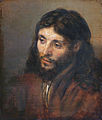
Rembrandt Harmenszoon van Rijn, usually simply known as Rembrandt, was a Dutch Golden Age painter, printmaker, and draughtsman. He is generally considered one of the greatest visual artists in the history of art. It is estimated Rembrandt produced a total of about three hundred paintings, three hundred etchings, and two thousand drawings.
Thomas Scott Kaplan is an American businessman, philanthropist and art collector. He is the world's largest private collector of Rembrandt's works.
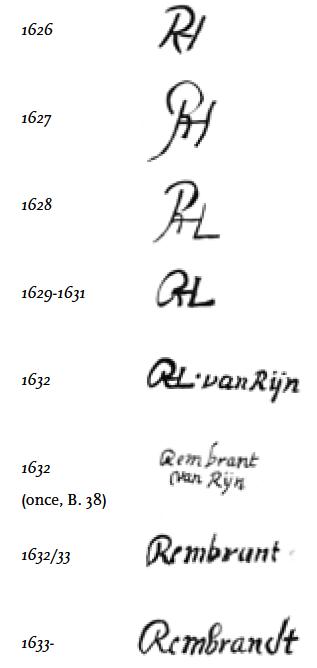
The Rembrandt Research Project (RRP) was an initiative of the Nederlandse Organisatie voor Wetenschappelijk Onderzoek (NWO), which is the Netherlands Organization for Scientific Research. Its purpose was to organize and categorize research on Rembrandt van Rijn, with the aim of discovering new facts about this Dutch Golden Age painter and his studio. The project started in 1968 and was sponsored by NWO until 1998. Research continued until 2014. It was the authority on Rembrandt and had the final say in whether a painting is genuine. The documentation generated by the project was transferred to the Netherlands Institute for Art History and renamed the Rembrandt Database.

The Polish Rider is a seventeenth-century painting by Rembrandt, usually dated to the 1650s, of a young man traveling on horseback through a murky landscape, now in The Frick Collection in New York. When the painting was sold by Zdzisław Tarnowski to Henry Frick in 1910, there was consensus that the work was by the Dutch painter Rembrandt. This attribution has since been contested, though those who contest it remain in the minority.
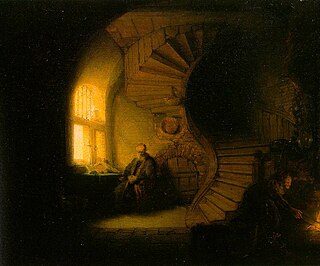
Philosopher in Meditation, recently renamed Philosopher in Contemplation by the museum, is the traditional title of an oil painting in the Musée du Louvre, Paris, that is attributed to the 17th-century Dutch artist Rembrandt.

Salvator Mundi is a painting attributed in whole or in part to the Italian High Renaissance artist Leonardo da Vinci, dated to c. 1499–1510. Long thought to be a copy of a lost original veiled with overpainting, it was rediscovered, restored, and included in an exhibition of Leonardo's work at the National Gallery, London, in 2011–2012. Christie's, which sold the work in 2017, stated that most leading scholars consider it an original work by Leonardo, but this attribution has been disputed by other leading specialists, some of whom propose that he only contributed certain elements; others believe that the extensive restoration prevents a definitive attribution.

The dozens of self-portraits by Rembrandt were an important part of his oeuvre. Rembrandt created approaching one hundred self-portraits including over forty paintings, thirty-one etchings and about seven drawings; some remain uncertain as to the identity of either the subject or the artist, or the definition of a portrait.

Horst Gerson was a German-Dutch art historian.
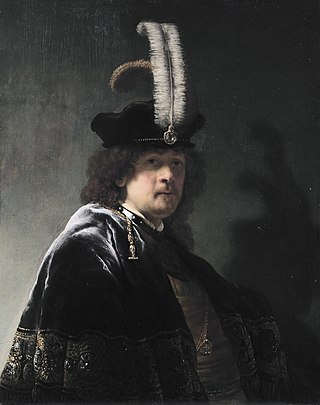
Self-portrait wearing a white feathered bonnet is an oil painting attributed to the Dutch painter Rembrandt. It is signed and dated 1635. It was traditionally regarded as a Rembrandt self-portrait until 1968, when it was rejected on stylistic grounds in the Rembrandt catalogue raisonné by Horst Gerson. In 2013, art historian Ernst van de Wetering re-attributed the painting as an original Rembrandt. It is one of over 40 painted self-portraits by Rembrandt.

The Head of Christ is a 1648 oil-on-panel painting by the Dutch artist Rembrandt. It is now in the Gemäldegalerie in Berlin.

Portrait of a Man with Arms Akimbo, formerly known as Portrait of a Foreign Admiral or Portrait of a Dutch Admiral, is an oil painting portrait by Rembrandt signed and dated 1658. It is now in the collection of the Agnes Etherington Art Centre at Queen's University in Kingston, Ontario, and measures 107.4 cm by 87.0 cm.

Slaughtered Ox, also known as Flayed Ox, Side of Beef, or Carcass of Beef, is a 1655 oil on beech panel still life painting by Rembrandt. It has been in the collection of the Louvre in Paris since 1857. A similar painting is in Kelvingrove Art Gallery and Museum, Glasgow, possibly not created by Rembrandt himself but probably by one of his pupils, perhaps Carel Fabritius. Other similar paintings by Rembrandt or more likely his circle are held by museums in Budapest and Philadelphia.
Bob Haak was a Dutch art expert known mostly as one of the founders of the Rembrandt Research Project.
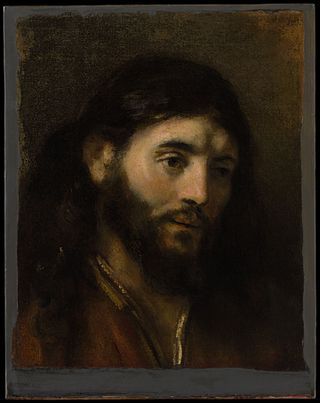
Head of Christ is a 1650s painting by Rembrandt's workshop. It shows Christ with a beard and long dark hair. It is in the collection of the Metropolitan Museum of Art.

Head of Christ is a 17th-century painting by Rembrandt's workshop. It shows Christ with a beard and long dark hair. It is in the collection of the Philadelphia Museum of Art, in Philadelphia, Pennsylvania.
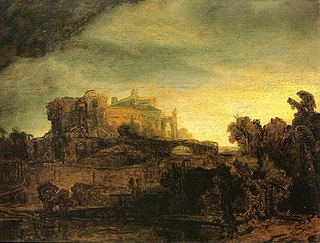
Landscape with a Castle is an oil-on-panel painting by Rembrandt, now in the Louvre in Paris. Art historians have variously dated it to 1652, 1654, early 1640, 1648, 1640-1642, c.1640 and 1643–1646.

The Preacher Eleazar Swalmius is a 1637 oil-on-canvas painting by the Dutch artist Rembrandt. It is currently owned by the Royal Museum of Fine Arts in Antwerp. The painting has been certified a real Rembrandt. The painting was listed in 1727 in the catalog of the Duke of Orléans collection, as a portrait of an Amsterdam mayor by Rembrandt. It remained in the noble family's possession until 1792, when Duke Louis-Philippe-Joseph sold the entire collection to finance his political career and pay off debts. The painting passed through several English collections into the hands of the Bourgeois brothers, art dealers from Cologne, who sold the painting as an original Rembrandt to the museum in 1886. The painting was stored away for a long time due to doubts cast over its authenticity.
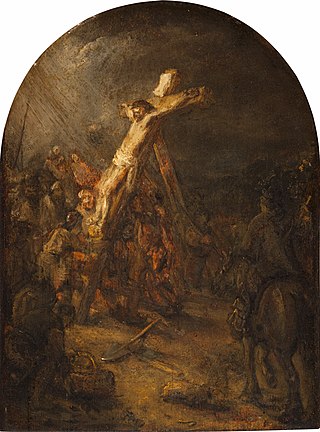
Raising of the Cross is a circa 1633-1645 painting by the Dutch Golden Age painter Rembrandt in the collection of the Museum Bredius. It was assumed to have been painted as a study for Rembrandt's larger painting of the same subject, as part of a series commissioned in 1633 by Frederick Henry, Prince of Orange. Having been rejected as autograph by the Rembrandt Research Project after Abraham Bredius's death, it was recently reattributed to the master by Jeroen Giltaij, though dendrochronology indicates the wood for the panel was not felled before 1642.
Head of Christ is a 1940 portrait painting of Jesus by Warner Sallman.

The Feast of Bacchus is an oil-on-canvas painting that was completed in 1654 by the Dutch painter Philips Koninck. The painting is on display at the Museum Bredius in The Hague. Once thought to be an allegory of the five senses, it may depict a festival held by the Amsterdam Guild of Saint Luke, a celebration of the Bentvueghels, or a meeting of the Chamber of Rhetoric.


